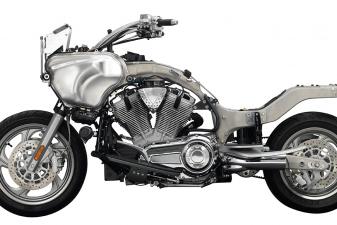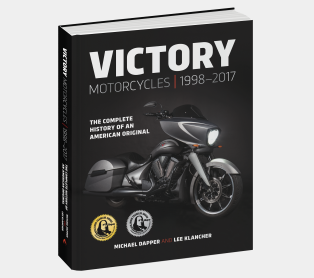Design & Development of the Victory Vegas, Part 2
By Michael Dapper

In part two of Michael Dapper's exploration into the design and development of the Victory Vegas, original Victory Product Manager Gary Laskin sheds light on some of the model's most celebrated characteristics: its signature raised-spine fuel tank, classic metallic paint, and iconic name. Read about the origins of the model in Design & Development of the Victory Vegas, Part 1, and find every Victory model produced (and even those that didn't make it into production!) in Victory Motorcycles 1998–2017.
Banner image: The flames shown on the test bike did make it into production as “Tribal Flames.” A late-2002 issue of Victory Magazine included this photo and reported: “For 2003, the Tribal Flames paint scheme will be available only on the Vegas and in very limited numbers.” Versions of Tribal Flames were used for several years on multiple Victory models. Victory
The developmental history of the Vegas—Project name: Custom Cruiser (CC)—verifies that product teams have to be capable of working in multiple time frames: the present and the future.
Gary Laskin, the original product manager for Victory, said the initial concept for the Vegas was completed by the fall of 1999. At that time, the only models in production were the V92C, its limited-edition SE derivative, and the V92SC, the SportCruiser. So while Victory team members were looking at their extant retro-style cruisers, they were also working on the radically different CC. (Plus, the retro-styled V92TC Touring Cruiser that was introduced in 2001 as a 2002 model.)
To learn if they were headed in the right direction with the CC, the Victory team presented the CC—and several other concepts—to focus groups. One such group was invited to the Polaris engineering and production facility in Osceola, Wisconsin, during Wheels and Wings: a car, bike, and aircraft show held each September.
“We did a focus group during Wheels and Wings where we had 100 Victory owners in big meeting room where we had a mock-up of the Vegas and some other stuff, and had them take a survey,” Laskin said. “Everybody just loved it from the moment they saw it.”
He said he witnessed that positive response to the Vegas throughout his years with Victory: “The Vegas is the one product I’ve ever been involved in where the reaction of every single person who ever saw it was, 'Oh my god, I love that! I’ve never been involved with another product that was so universally liked.”
The Fuel Tank Challenge
Following that Osceola focus group however, the Victory team still faced significant manufacturing challenges. Finding a supplier who could create the unique Vegas fuel tank was particularly difficult. The tank has a raised spine running lengthwise atop the tank, scalloped sides, and a “V” at the tail that integrates with the pointed front end of the driver’s seat.
Laskin said, “A German company named Behr made the fuel tanks. They made tanks, oil coolers, and other components for BMW. No one could figure out how to make the tank on this bike because of the spine, the split tail that goes around the seat, and the scallops on the sides. Me, Mike Song, some [Victory] engineers, and these guys from Germany locked ourselves in a conference room in Osceola for two days. The toughest part was figuring out how to make the spine down the center.
“I remember this guy from Behr was on the phone with his people back in Germany, and he told us the process for making the tank would require [in German dialect] ‘stamping after velding! Stamping after velding!’ He kept repeating that.
“The original tank consisted of three pieces: two sides and the bottom. The sides were welded [together] down the center of the top, finished, then stamped again to make the spine.”
After a few years, Laskin recalled, “Behr shut that division down and we had to find a new supplier.”
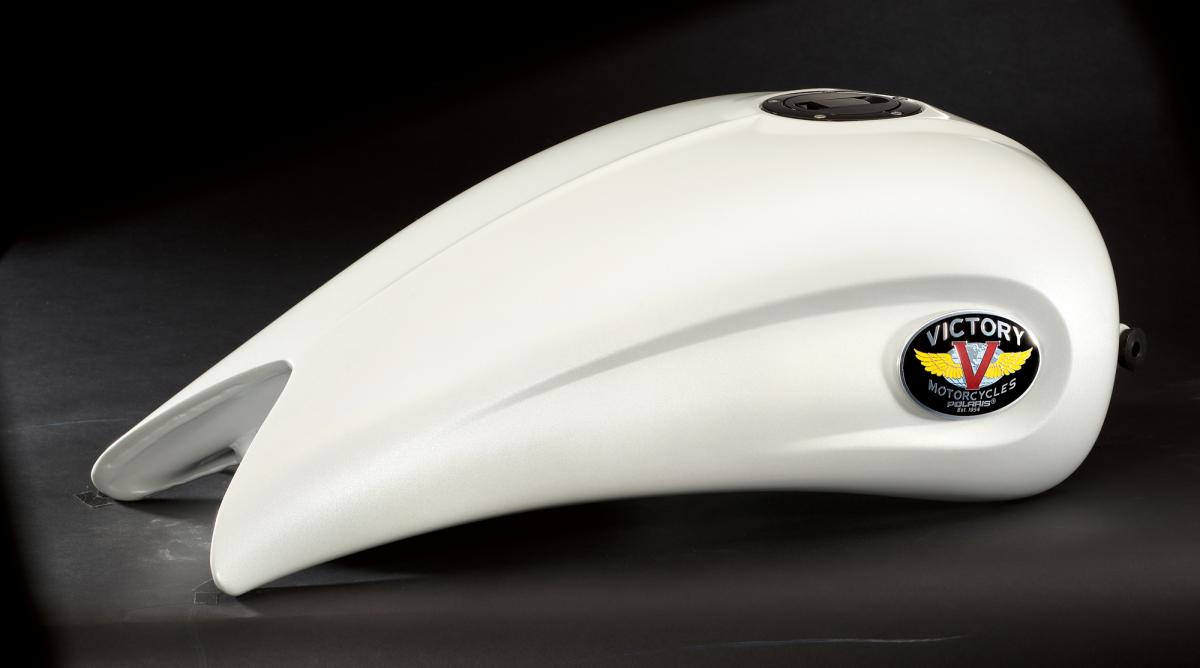 This Vegas fuel tank shows off the model's unique custom elements. Atop the tank is the raised spine that also ran the length of the front and rear fenders, and the sides are scalloped to host the tank badge. The split tail integrated with the front of the driver seat to create a smooth, custom-look style. Victory
This Vegas fuel tank shows off the model's unique custom elements. Atop the tank is the raised spine that also ran the length of the front and rear fenders, and the sides are scalloped to host the tank badge. The split tail integrated with the front of the driver seat to create a smooth, custom-look style. Victory
Naming the CC
As the CC neared production, a marketing name was needed for the new model. Laskin recalled the naming process:
“Naming products is super hard because most of the good names are already taken. We took suggestions from engineers, designers, marketing people. I had a list of about 300 potential names and people liked this name, hated this name. It’s super hard to get a name everybody likes.
“I met with [then-Marketing Manager] Darcy [Betlach] and [then-Polaris President Tom] Tiller on a Friday afternoon. We had the name ‘V92CC’ for Custom Cruiser. Tiller said nobody is going to like it. He said, ‘you’re coming in Monday and you’re going to have a name,’ and he walked out of the room.
“I literally got two books on how to name products and that weekend I read both of them. We wanted a name that was short–2 syllables or less–with alliteration so it starts with the letter V. When you have alliteration, recall goes way up. And I wanted it to be American.
“I got a dictionary and looked at every single word that begins with V. The thing about Vegas was that naming it after a place can really regionalize it. ‘Hollywood’ was a candidate, but in the end, ‘Vegas’ is not so much a place where you’re from, but it’s a destination, it’s a place that you go. ‘What happens in Vegas stays in Vegas,’ it’s kind of a bad boy name that totally fits. It fits so perfectly.
“Vegas was available as a trademark, so we didn’t have really any conflict.”
 This image was featured in ads and was widely distributed as a large poster that folded up to become the original Vegas brochure. Victory
This image was featured in ads and was widely distributed as a large poster that folded up to become the original Vegas brochure. Victory
The Iconic First Photo
The Vegas was introduced to Victory dealers in July 2002 as a 2003 model. The bike’s original promotional materials showed a silver Vegas in Las Vegas. The bike looked great, the Sin City settings were distinctive, and those photos live on in many riders’ memories.
“The original silver color was called Vogue Silver,” Laskin said. “All that paint [consists of] is aluminum metal flake and clear. No pigments and no dyes, just flake and clear.
“I still think it’s the best paint for showing the contours of the surface. It was also used on the original clay model because you can see the form better, and it’s a non-color, so it doesn’t skew results in focus groups.”
That silver clay mock-up is what was shown to the focus groups in Osceola. It made a positive impact then, and the silver production model made a similarly positive impact when introduced to the motorcycle world in mid-2002.
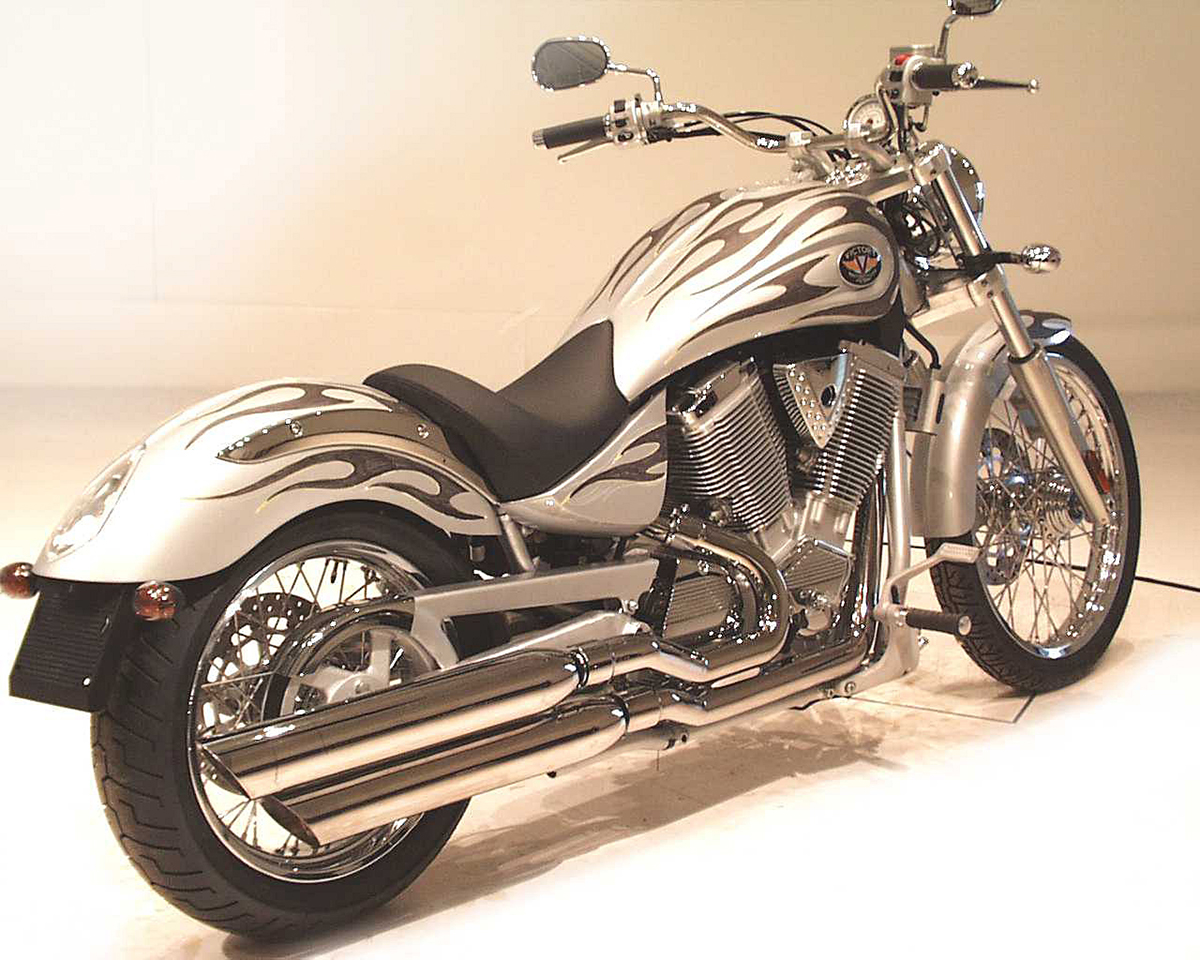 Per Gary Laskin: “This is a mockup of flame accessory paint proposal. [It] has flames that look like they were made with tape and then colored in with marker… Steve Leszinski [of the Industrial Design team] developed that graphic.” Gary noted that “an earlier [developmental] bike [was] used to develop the graphics. Notice the taillight has a clear lens. It was a pre-production sample. The original taillight concept was to have a clear lens with red LEDs inside. But the taillight visibility got washed out in direct sunlight, so we changed to a red lens with white LEDs inside the light.” Gary Laskin
Per Gary Laskin: “This is a mockup of flame accessory paint proposal. [It] has flames that look like they were made with tape and then colored in with marker… Steve Leszinski [of the Industrial Design team] developed that graphic.” Gary noted that “an earlier [developmental] bike [was] used to develop the graphics. Notice the taillight has a clear lens. It was a pre-production sample. The original taillight concept was to have a clear lens with red LEDs inside. But the taillight visibility got washed out in direct sunlight, so we changed to a red lens with white LEDs inside the light.” Gary Laskin
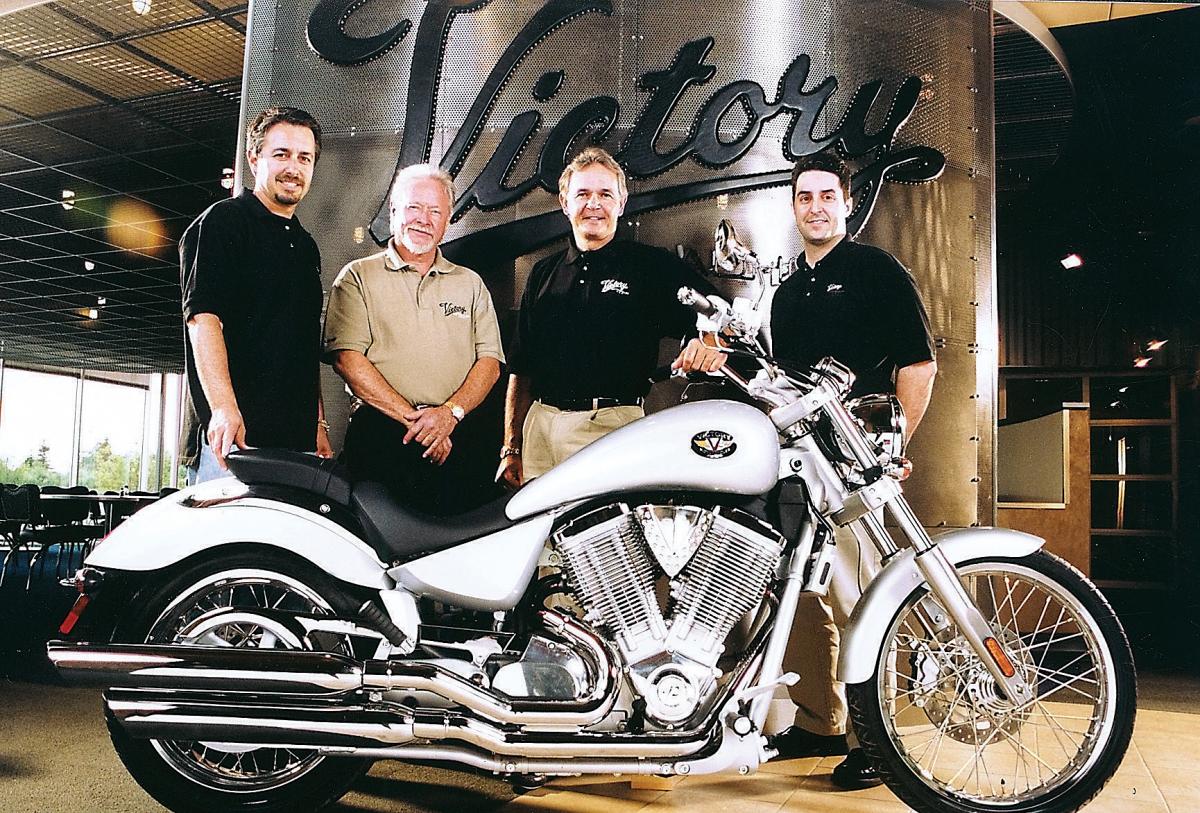 Shown with a 2003 Vegas are (left to right): legendary custom builders, Victory dealers, and Victory styling consultants Cory Ness and Arlen Ness; Mark Blackwell, the third General Manager in Victory history; and Gary Laskin, the brand’s first product manager who helped fuel the re-invention of Victory as a brand of modern, stylish, and powerful cruisers. This photo was taken at the Victory Roadhouse, the employee restaurant at Polaris HQ in Medina, Minn. (The restaurant has since been renamed for Indian Motorcycle.) Victory
Shown with a 2003 Vegas are (left to right): legendary custom builders, Victory dealers, and Victory styling consultants Cory Ness and Arlen Ness; Mark Blackwell, the third General Manager in Victory history; and Gary Laskin, the brand’s first product manager who helped fuel the re-invention of Victory as a brand of modern, stylish, and powerful cruisers. This photo was taken at the Victory Roadhouse, the employee restaurant at Polaris HQ in Medina, Minn. (The restaurant has since been renamed for Indian Motorcycle.) Victory
 During Daytona Bike Week in March 2003, Christina Scott of Lake City, Florida, purchased the first Vegas ever sold at retail. The model had just gone into production and the first units were rushed from the Spirit Lake, Iowa, factory to the Arlen Ness Motorcycles dealership on Beach Street, where this photo was taken. Michael Dapper
During Daytona Bike Week in March 2003, Christina Scott of Lake City, Florida, purchased the first Vegas ever sold at retail. The model had just gone into production and the first units were rushed from the Spirit Lake, Iowa, factory to the Arlen Ness Motorcycles dealership on Beach Street, where this photo was taken. Michael Dapper
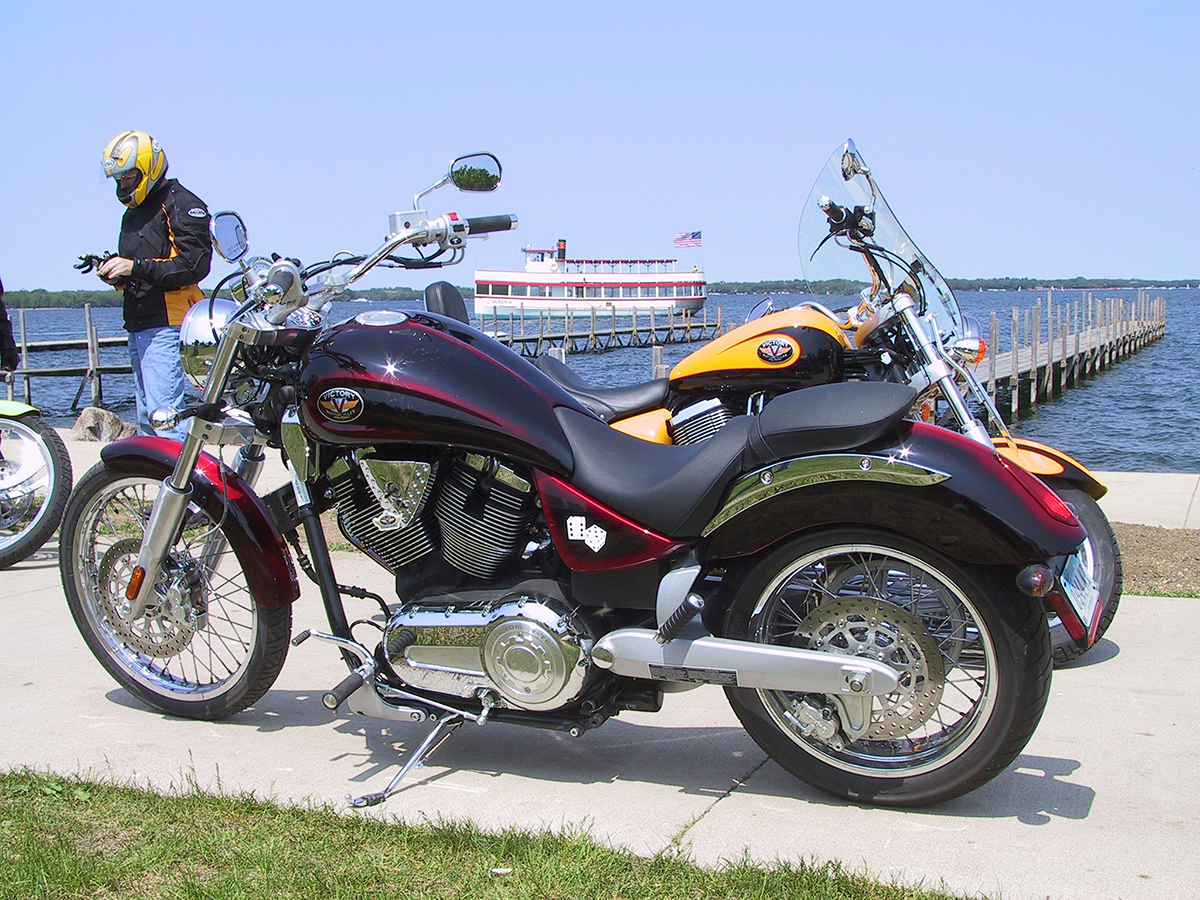 During the 2003 American Victory Rally, this custom-painted Vegas was among the demo bikes consumers could ride. While everyone admired this bike’s cool, one-off paint scheme, they didn’t realize they were looking at what would be introduced one year later (without the dice on the side cover) as the limited-edition Arlen Ness Signature Series Victory Vegas. Demo rides in those early days of the rally were based along the shoreline of West Okoboji Lake. Michael Dapper
During the 2003 American Victory Rally, this custom-painted Vegas was among the demo bikes consumers could ride. While everyone admired this bike’s cool, one-off paint scheme, they didn’t realize they were looking at what would be introduced one year later (without the dice on the side cover) as the limited-edition Arlen Ness Signature Series Victory Vegas. Demo rides in those early days of the rally were based along the shoreline of West Okoboji Lake. Michael Dapper
Check out the Octane Press FUEL Blog for “Design & Development of the Victory Vegas, Part 1,” which covers the initial inspiration for the Vegas, and details steps in its developmental history.
Banner image: The flames shown on the test bike did make it into production as “Tribal Flames.” A late-2002 issue of Victory Magazine included this photo and reported: “For 2003, the Tribal Flames paint scheme will be available only on the Vegas and in very limited numbers.” Versions of Tribal Flames were used for several years on multiple Victory models. Victory
The developmental history of the Vegas—Project name: Custom Cruiser (CC)—verifies that product teams have to be capable of working in multiple time frames: the present and the future.
Gary Laskin, the original product manager for Victory, said the initial concept for the Vegas was completed by the fall of 1999. At that time, the only models in production were the V92C, its limited-edition SE derivative, and the V92SC, the SportCruiser. So while Victory team members were looking at their extant retro-style cruisers, they were also working on the radically different CC. (Plus, the retro-styled V92TC Touring Cruiser that was introduced in 2001 as a 2002 model.)
To learn if they were headed in the right direction with the CC, the Victory team presented the CC—and several other concepts—to focus groups. One such group was invited to the Polaris engineering and production facility in Osceola, Wisconsin, during Wheels and Wings: a car, bike, and aircraft show held each September.
“We did a focus group during Wheels and Wings where we had 100 Victory owners in big meeting room where we had a mock-up of the Vegas and some other stuff, and had them take a survey,” Laskin said. “Everybody just loved it from the moment they saw it.”
He said he witnessed that positive response to the Vegas throughout his years with Victory: “The Vegas is the one product I’ve ever been involved in where the reaction of every single person who ever saw it was, 'Oh my god, I love that! I’ve never been involved with another product that was so universally liked.”
The Fuel Tank Challenge
Following that Osceola focus group however, the Victory team still faced significant manufacturing challenges. Finding a supplier who could create the unique Vegas fuel tank was particularly difficult. The tank has a raised spine running lengthwise atop the tank, scalloped sides, and a “V” at the tail that integrates with the pointed front end of the driver’s seat.
Laskin said, “A German company named Behr made the fuel tanks. They made tanks, oil coolers, and other components for BMW. No one could figure out how to make the tank on this bike because of the spine, the split tail that goes around the seat, and the scallops on the sides. Me, Mike Song, some [Victory] engineers, and these guys from Germany locked ourselves in a conference room in Osceola for two days. The toughest part was figuring out how to make the spine down the center.
“I remember this guy from Behr was on the phone with his people back in Germany, and he told us the process for making the tank would require [in German dialect] ‘stamping after velding! Stamping after velding!’ He kept repeating that.
“The original tank consisted of three pieces: two sides and the bottom. The sides were welded [together] down the center of the top, finished, then stamped again to make the spine.”
After a few years, Laskin recalled, “Behr shut that division down and we had to find a new supplier.”
 This Vegas fuel tank shows off the model's unique custom elements. Atop the tank is the raised spine that also ran the length of the front and rear fenders, and the sides are scalloped to host the tank badge. The split tail integrated with the front of the driver seat to create a smooth, custom-look style. Victory
This Vegas fuel tank shows off the model's unique custom elements. Atop the tank is the raised spine that also ran the length of the front and rear fenders, and the sides are scalloped to host the tank badge. The split tail integrated with the front of the driver seat to create a smooth, custom-look style. VictoryNaming the CC
As the CC neared production, a marketing name was needed for the new model. Laskin recalled the naming process:
“Naming products is super hard because most of the good names are already taken. We took suggestions from engineers, designers, marketing people. I had a list of about 300 potential names and people liked this name, hated this name. It’s super hard to get a name everybody likes.
“I met with [then-Marketing Manager] Darcy [Betlach] and [then-Polaris President Tom] Tiller on a Friday afternoon. We had the name ‘V92CC’ for Custom Cruiser. Tiller said nobody is going to like it. He said, ‘you’re coming in Monday and you’re going to have a name,’ and he walked out of the room.
“I literally got two books on how to name products and that weekend I read both of them. We wanted a name that was short–2 syllables or less–with alliteration so it starts with the letter V. When you have alliteration, recall goes way up. And I wanted it to be American.
“I got a dictionary and looked at every single word that begins with V. The thing about Vegas was that naming it after a place can really regionalize it. ‘Hollywood’ was a candidate, but in the end, ‘Vegas’ is not so much a place where you’re from, but it’s a destination, it’s a place that you go. ‘What happens in Vegas stays in Vegas,’ it’s kind of a bad boy name that totally fits. It fits so perfectly.
“Vegas was available as a trademark, so we didn’t have really any conflict.”
 This image was featured in ads and was widely distributed as a large poster that folded up to become the original Vegas brochure. Victory
This image was featured in ads and was widely distributed as a large poster that folded up to become the original Vegas brochure. VictoryThe Iconic First Photo
The Vegas was introduced to Victory dealers in July 2002 as a 2003 model. The bike’s original promotional materials showed a silver Vegas in Las Vegas. The bike looked great, the Sin City settings were distinctive, and those photos live on in many riders’ memories.
“The original silver color was called Vogue Silver,” Laskin said. “All that paint [consists of] is aluminum metal flake and clear. No pigments and no dyes, just flake and clear.
“I still think it’s the best paint for showing the contours of the surface. It was also used on the original clay model because you can see the form better, and it’s a non-color, so it doesn’t skew results in focus groups.”
That silver clay mock-up is what was shown to the focus groups in Osceola. It made a positive impact then, and the silver production model made a similarly positive impact when introduced to the motorcycle world in mid-2002.
 Per Gary Laskin: “This is a mockup of flame accessory paint proposal. [It] has flames that look like they were made with tape and then colored in with marker… Steve Leszinski [of the Industrial Design team] developed that graphic.” Gary noted that “an earlier [developmental] bike [was] used to develop the graphics. Notice the taillight has a clear lens. It was a pre-production sample. The original taillight concept was to have a clear lens with red LEDs inside. But the taillight visibility got washed out in direct sunlight, so we changed to a red lens with white LEDs inside the light.” Gary Laskin
Per Gary Laskin: “This is a mockup of flame accessory paint proposal. [It] has flames that look like they were made with tape and then colored in with marker… Steve Leszinski [of the Industrial Design team] developed that graphic.” Gary noted that “an earlier [developmental] bike [was] used to develop the graphics. Notice the taillight has a clear lens. It was a pre-production sample. The original taillight concept was to have a clear lens with red LEDs inside. But the taillight visibility got washed out in direct sunlight, so we changed to a red lens with white LEDs inside the light.” Gary Laskin Shown with a 2003 Vegas are (left to right): legendary custom builders, Victory dealers, and Victory styling consultants Cory Ness and Arlen Ness; Mark Blackwell, the third General Manager in Victory history; and Gary Laskin, the brand’s first product manager who helped fuel the re-invention of Victory as a brand of modern, stylish, and powerful cruisers. This photo was taken at the Victory Roadhouse, the employee restaurant at Polaris HQ in Medina, Minn. (The restaurant has since been renamed for Indian Motorcycle.) Victory
Shown with a 2003 Vegas are (left to right): legendary custom builders, Victory dealers, and Victory styling consultants Cory Ness and Arlen Ness; Mark Blackwell, the third General Manager in Victory history; and Gary Laskin, the brand’s first product manager who helped fuel the re-invention of Victory as a brand of modern, stylish, and powerful cruisers. This photo was taken at the Victory Roadhouse, the employee restaurant at Polaris HQ in Medina, Minn. (The restaurant has since been renamed for Indian Motorcycle.) Victory During Daytona Bike Week in March 2003, Christina Scott of Lake City, Florida, purchased the first Vegas ever sold at retail. The model had just gone into production and the first units were rushed from the Spirit Lake, Iowa, factory to the Arlen Ness Motorcycles dealership on Beach Street, where this photo was taken. Michael Dapper
During Daytona Bike Week in March 2003, Christina Scott of Lake City, Florida, purchased the first Vegas ever sold at retail. The model had just gone into production and the first units were rushed from the Spirit Lake, Iowa, factory to the Arlen Ness Motorcycles dealership on Beach Street, where this photo was taken. Michael Dapper During the 2003 American Victory Rally, this custom-painted Vegas was among the demo bikes consumers could ride. While everyone admired this bike’s cool, one-off paint scheme, they didn’t realize they were looking at what would be introduced one year later (without the dice on the side cover) as the limited-edition Arlen Ness Signature Series Victory Vegas. Demo rides in those early days of the rally were based along the shoreline of West Okoboji Lake. Michael Dapper
During the 2003 American Victory Rally, this custom-painted Vegas was among the demo bikes consumers could ride. While everyone admired this bike’s cool, one-off paint scheme, they didn’t realize they were looking at what would be introduced one year later (without the dice on the side cover) as the limited-edition Arlen Ness Signature Series Victory Vegas. Demo rides in those early days of the rally were based along the shoreline of West Okoboji Lake. Michael DapperCheck out the Octane Press FUEL Blog for “Design & Development of the Victory Vegas, Part 1,” which covers the initial inspiration for the Vegas, and details steps in its developmental history.




